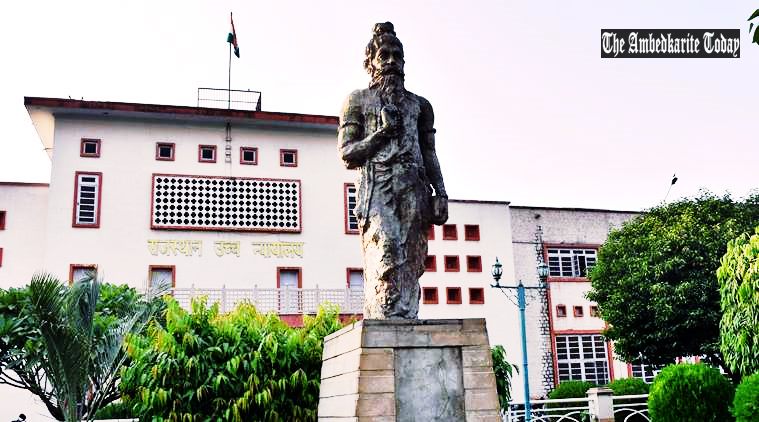A reader of the Manu Smriti will find that Manu for the purposes of his discussion groups the various castes under certain specific heads namely (1) Aryan Castes, (2) Non-Aryan Castes, (3) Vratya Castes, (4) Fallen Castes and (5) Sankara Castes.
By Aryan Castes he means the four varnas namely Brahmana, Kshatriya, Vaishya and Shudra. In other words, Manu regards the system of Chaturvarna to be the essence of Aryanism. By Non-Aryan Castes he means those communities who do not accept the creed of Chaturvarna and he, cites the community called Dasyu as an illustration of those whom he regards as a Non-Aryan community1 . By Vratyas he means those castes who were once believers in the Chaturvarna but who had rebelled against it.
The list of Vratyas given by Manu includes the following castes:
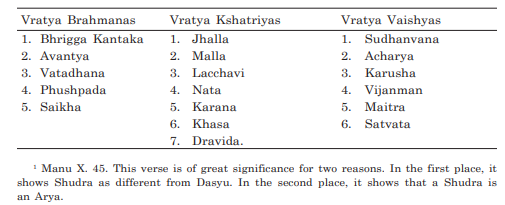
In the list of Fallen Castes Manu includes those Kshatriyas who have become Shudras by reason of the disuse of Aryan rites and ceremonies and loss of services of the Brahmin priests. They are enumerated by Manu as under:
- Paundrakas
- Cholas
- Dravidas
- Kambhojas
- Yavanas
- Sakas
- Paradas
- Pahlvas
- Chinas
- Kiratas
- Daradas
By Sankara Castes Manu means Castes the members of which are born of parents who do not belong to the same caste.
These mixed castes he divides into various categories (1) Progeny of different Aryan Castes which he subdivides into two classes (a) Anuloma and (b) Pratiloma, (2) Progeny of Anuloma and Pratiloma Castes and (3) Progeny of Non-Aryan and the Aryan Anuloma and Pratiloma Castes. Those included by Manu under the head of mixed castes are shown below under different categories:
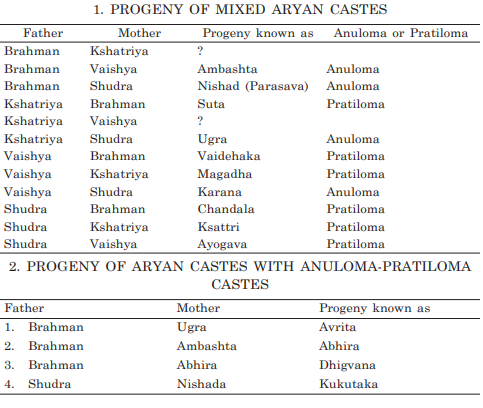

To Manu’s list of Sankar (mixed) Castes additions have been made by his successors. Among these are the authors of Aushanas Smriti, Baudhayana Smriti, Vashistha Smriti, Yajnavalkya Smriti and the Suta Sanhita
Of these additions four have been made by the Aushanas Smriti. They are noted below:
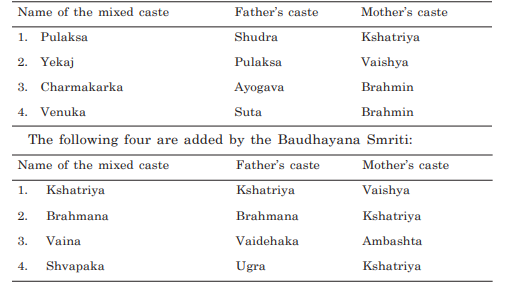
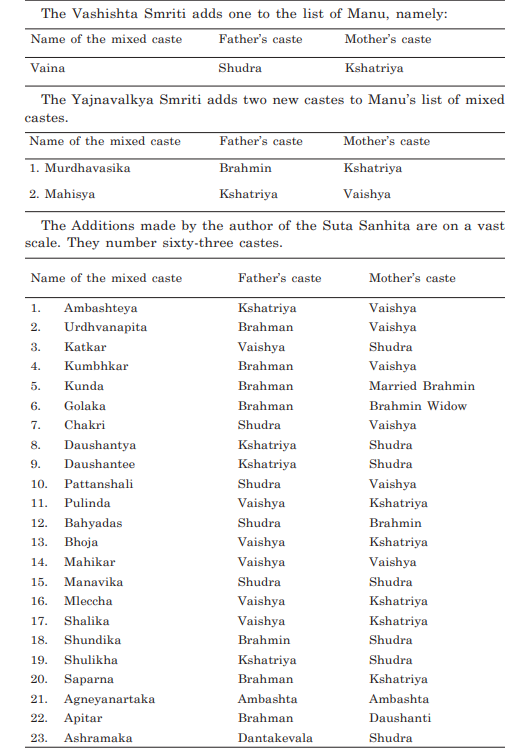
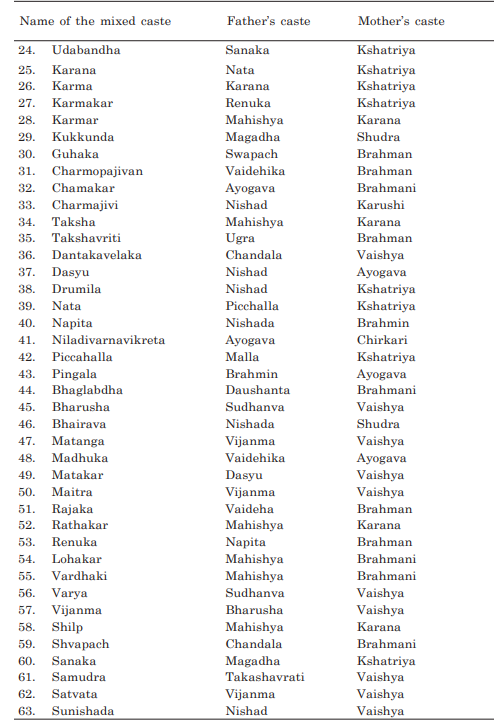
Of the five categories of castes it is easy to understand the explanation given by Manu as regards the first four. But the same cannot be said in respect of his treatment of the fifth category namely the Sankar (mixed) caste. There are various questions that begin to trouble the mind. In the first place Manu’s list of mixed castes is a perfunctory list. It is not an exhaustive list, stating all the possibilities of Sankar.
In discussing the mixed castes born out of the mixture of the Aryan castes with the Anuloma-Pratiloma castes, Manu should have specified the names of castes which are the progeny of each of the four Aryan castes with each of the 12 Anuloma-Pratiloma castes. If he had done so we should have had a list of forty-eight resulting castes. As a matter of fact he states only the names of four castes of mixed marriages of this category.
In discussing the progeny of mixed marriages between Anuloma- Pratiloma castes given the fact that we have 12 of them, Manu should have given the names of 144 resulting castes. As a matter of fact, Manu only gives a list of 11 castes. In the formation of these 11 castes, Manu gives five possible combinations of 5 castes only. Of these one (Vaideha) is outside the Anuloma-Pratiloma list. The case of the 8 are not considered at all.
His account of the Sankar castes born out of the Non-Aryan and the Aryan castes is equally discrepant. We ought to have had first a list of castes resulting from a combination between the Non-Aryans with each of the four Aryan castes. We have none of them. Assuming that there was only one Non-Aryan caste—Dasyu—we ought to have had a list of 12 castes resulting from a conjugation of Dasyus with each of the Anuloma-Pratiloma castes. As a matter of fact we have in Manu only one conjugation.
In the discussion of this subject of mixed castes Manu does not consider the conjugation between the Vratyas and the Aryan castes, the Vratyas and the Anuloma-Pratiloma castes, the Vratyas and the Non-Aryan castes.
Among these omissions by Manu there are some that are glaring as well as significant. Take the case of Sankar between Brahmins and Kshatriyas. He does not mention the caste born out of the Sankar between these two. Nor does he mention whether the Sankar caste begotten of these two was a Pratiloma or Anuloma. Why did Manu fail to deal with this question. Is it to be supposed that such a Sankar did not occur in his time? Or was he afraid to mention it? If so, of whom was he afraid ?
Some of the names of the mixed castes mentioned by Manu and the other Smritikaras appear to be quite fictitious.
For some of the communities mentioned as being of bastard origin have never been heard of before Manu. Nor does any one know what has happened to them since. They are today non-existent without leaving any trace behind. Caste is an insoluble substance and once a caste is formed it maintains its separate existence, unless for any special reason it dies out. This can happen but to a few.
Who are the Ayogava, Dhigvana, Ugra, Pukkasa, Svapaka, Svapacha, Pandusopaka, Ahindaka, Bandika, Matta, Mahikar, Shalika, Shundika, Shulika, Yekaj, Kukunda to mention only a few. Where are they? What has happened to them?
Let us now proceed to compare Manu with the rest of Smritikars. Are they unanimous on the origin of the various mixed castes referred to by them? Far from it compare the following cases.
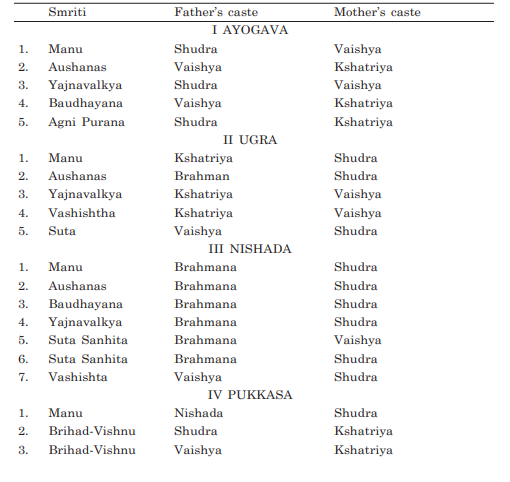
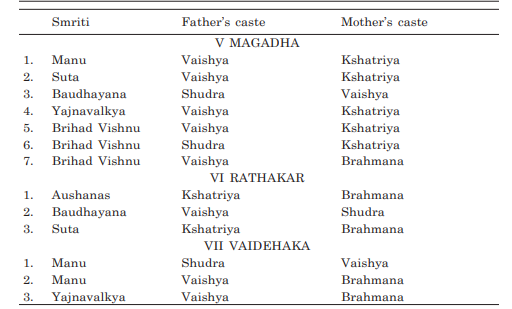
If these different Smritikaras are dealing with facts about the origin and genesis of the mixed castes mentioned above how can such a wide difference of opinion exist among them? The conjugation of two castes can logically produce a third mixed caste. But how the conjugation of the same two castes produce a number of different castes ? But this is exactly what Manu and his followers seem to be asserting. Consider the following cases:
I. Conjugation of Kshatriya father and Vaishya mother.
- Baudhyayana says that the caste of the progeny is Kshatriya.
- Yajnavalkya says it is Mahishya.
- Suta says it is Ambashta.
II. Conjugation of Shudra father and Kshatriya mother—
- Manu says the Progeny is Ksattri.
- Aushanas says it is Pullaksa.
- Vashishta says it is Vaina.
III. Conjugation of Brahmana father and Vaishya mother.
- Manu says that the progeny is called Ambashta.
- Suta once says it is called Urdhava Napita but again says it is called Kumbhakar
IV. Conjugation of Vaishya father and Kshatriya mother—
- Manu says that the progeny is called Magadha
- Suta states that (1) Bhoja, (2) Mleccha, (3) Shalik and (4) Pulinda are the Progenies of this single conjugation.
V. Conjugation of Kshatriya father and Shudra mother—
- Manu says that the progeny is called Ugra.
- Suta says that (1) Daushantya, (2) Daushantee and (3) Shulika are the progenies of this single conjugation.
VI. Conjugation of Shudra father and Vaishya mother—
- Manu says the progeny is called Ayogava.
- Suta says the progeny is (1) Pattanshali and (2) Chakri.
Let us take up another question. Is Manu’s explanation of the genesis of the mixed castes historically true?
To begin with the Abhira. According to Manu the Abhiras are the bastards born of Brahmin males and Ambashta females. What does history say about them? History says that the Abhiras (the corrupt form of which is Ahira) were pastoral tribes which inhabited the lower districts of the North-West as far as Sindh. They were a ruling independent Tribe and according to the Vishnu Purana1 the Abhiras conquered Magadha and reigned there for several years.
The Ambashta2 says Manu are the bastards born of Brahmana male and Vaishya female. Patanjali speaks of Ambashtyas as those who are the natives of a country called Ambashta. That the Ambashtas were an independent tribe is beyond dispute. The Ambashtas are mentioned by Megasthenes the Greek Ambassador at the Court of Chandragupta Maurya as one of the tribes living in the Punjab who fought against Alexander when he invaded India. The Ambashtas are mentioned in the Mahabharata. They were reputed for their political system and for their bravery.
The Andhras3 says Manu are bastards of second degree in so far as they are the progeny of Vaidehaka male and Karavara female both of which belong to bastard castes. The testimony of history is quite different. The Andhras are a people who inhabited that part of the country which forms the eastern part of the Deccan Plateau. The Andhras are mentioned by Megasthenes. Pliny the Elder (77 A.D.) refers to them as a powerful tribe enjoying paramount sway over their land in the Deccan, possessed numerous villages, thirty walled towns defended by moats and lowers and supplies their king with an immense army consisting of 1,00,000 infantry, 2,000 cavalry and 1,000 elephants.
According to Manu the Magadhas1 are bastards born of Vaishya male and Kshatriya female. Panini the Grammarian gives quite a different derivation of ‘Magadha’. According to him “Magadha” means a person who comes from the country known as Magadha. Magadha corresponds roughly to the present Patna and Gaya districts of Bihar. The Magadhas have been mentioned as independent sovereign people right from the earliest times. They are first mentioned in the Atharva-Veda. The famous Jarasandha was the king of Magadha who was a contemporary of the Pandavas.
According to Manu the Nishadas are the bastards born caste from Brahmin males and Shudra females. History has quite a different tale to tell. The Nishadas were a native tribe with its own independent territory and its own kings. They are a very ancient tribe. The Ramayana mentions Guha as the King of Nishadas whose capital was Sringaverapura and who showed hospitality to Rama when he was undergoing excile in the forest.
As to the Vaidehaka Manu says that they are the bastards born of Vaishya Male and Brahmin female. Etymologically Vaidehaka means a person who is a native of the country called Videha2. Ancient Videha corresponds to the modern districts of Champaran and Darbhanga in Bihar. The country and its people have been known to history from a very remote antiquity. The Yajur-Veda mentions them. Ramayana refers to them. Sita the wife of Rama is the daughter of Janak who was the king of Videha and whose capital was Mithila.
Many more cases could be examined. Those that have been are quite sufficient to show how Manu has perverted history and defamed the most respectable and powerful tribes into bastards. This wholesale bastardization of huge communities Manu did not apply to the Vratyas. But his successors carried the scheme further and bastardized the Vratyas also. Karma in Manu is Vratya. But the Brahma Vaivarta Purana makes them Bastards and says that they are the progeny of Vaishya father and Shudra mother. Paundraka in Manu is Vratya. But in the Brahmavaivarta Purana he is a bastard born of Vaishya father and Chundi mother. Malla in Manu is Vratya. But in the Brahma Vaivarta Purana he is a bastard born of Letta father and Tibara mother. The Vharjjakautakas are Vratya Brahmanas according to Manu. But in the Gautama Sanhita they are bastards born from a Brahman father and Vaishya mother. The Yavanas were declared by Manu as Vratya Kshatriya. But in Gautama Sanhita they are shown as bastards born of a Kshatriya father and Shudra mother.
The Kiratas are according to Manu Vratya Kshatriyas. But the Ballalacharitta makes them bastards born from Vaishya father and Brahmin mother.
It is quite clear that some of the communities mentioned by Manu as being bastard in origin far from being bastard were independent in origin and yet Manu and the rest of the Smratikara’s call them Bastards. Why this madness on their part ? Is there a method in their madness?
Having regard to all these considerations it is a riddle why Manu at all raised the question of mixed castes and what he wanted to say about them? It is possible that Manu had realized that the Chaturvarna had failed
and that the existence of a large number of castes which should neither be described as Brahmanas, Kshatriyas, Vaishyas and Shudras was the best proof of the break down of the Chaturvarna and that he was therefore called upon to explain how these castes who were outside the Chaturvarna came into existence notwithstanding the rule of Chaturvarnas.
But did Manu realize how terrible is the Explanation which he has given? What does his explanation amount to?
What a reflection on the character of men and particularly of women. It is obvious that the unions of men and women must have been clandestine because prohibited by the rule of Chaturvarna. Such clandestine unions could take place only here and there. They could not have taken place on a wholesale scale. But unless one assumes a wholesale state of promiscuity how can one justify the origin of the Chandals or untouchables as given by Manu.
The caste of Chandala is said by Manu to be the progeny of illegitimate intercourse between a Shudra male and a Brahman female. Can this be true? It means that Brahmin women must have been very lax in their morality and must have had special sexual attraction for the Shudra1. This is unbelievable.
So vast is the Chandala population that even if every Brahmin female was a mistress of a Shudra it could not account of the vast number of Chandalas in the country.
Did Manu realize by propounding his theory of the origin of the mixed castes he was assigning an ignoble origin to a vast number of the people of this country leading to their social and moral degradation. Why did he say that the castes were mixed in origin, when as a matter of fact they were independent in their existence?
This Article is taken from Babasaheb Ambedkar’s book Riddles in Hinduism

